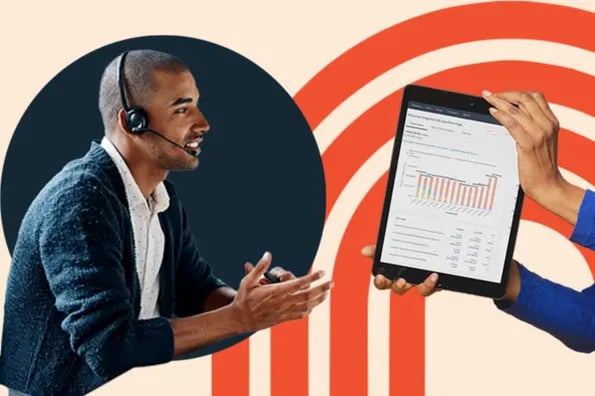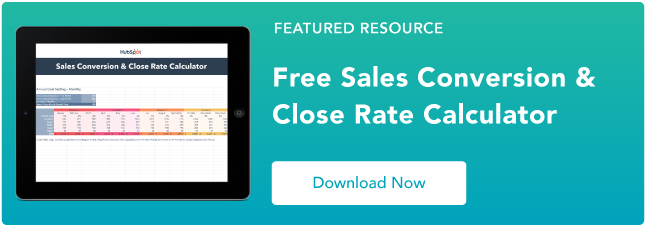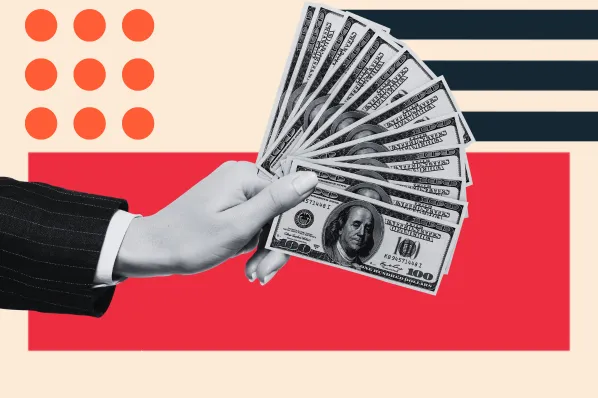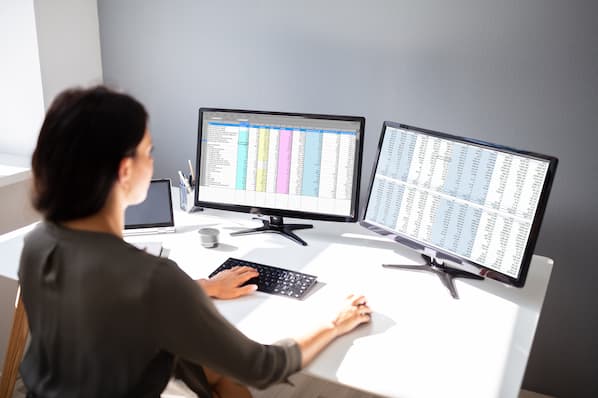If you’re a business owner like me, you’re probably familiar with the terms demand forecasting and sales forecasting. Ultimately, these are strategies you can use to predict demand and revenue, ensuring you have enough resources on hand and enough money coming in. But as with all things, it’s not always that simple. Not to mention, figuring out the difference between demand forecasting vs sales forecasting can be tricky too.

In my experience as a business owner, demand forecasting and sales forecasting have been more challenging post-pandemic. In 2020, seemingly overnight, every business owner realized they did, in fact, run an ecommerce business, and needed an effective, modern website and content strategy, stat. The need for copywriters — and therefore, my services — skyrocketed.
Yet, with the uncertainties of the last few years, demand (and in turn, sales) has been more difficult to forecast. It’s not just me saying this, it’s true for just about every business leader I’ve spoken with. I’m here to walk you through everything you need to know about demand forecasting vs sales forecasting — and why both are a must.
Demand Forecasting vs. Sales Forecasting
Demand forecasting and sales forecasting connect intrinsically, with a unified goal of helping businesses make informed decisions. However, they remain two separate strategies. It’s not a question of whether you sould use demand forecasting vs sales forecasting, however — both strategies have a place in your business.
Jason Smit of Contentellect offers a simple comparison, “In our business, demand forecasting takes a wider market view while sales forecasting focuses on our specific pipeline. Demand models ensure we have enough creator capacity while sales forecasts keep pipelines moving.”
Another way to look at it is that demand forecasting takes the long view, while sales forecasting looks at shorter term goals, impacts, and benchmarks.
To dive deeper, I’ll walk you through what demand forecasting vs sales forecasting offer individually.
Demand Forecasting — What is it?
While demand forecasting itself can be challenging, the definition is quite simple. First, you should predict how many units people will want to purchase, and then you’ll know what you should have on hand to meet that demand.
Of course, the definition of “units” depends on what you’re selling. In professional services businesses like mine, defining a “unit” can mean specific types of projects or hours. For example, in my business, a unit might refer to a single retainer, a brand messaging guide, copy for a new website, or a strategy call. And having enough “supply” means ensuring that my team has sufficient bandwidth or resources to manage the flow of projects.
On the other hand, for Kali Bennett, owner of The Waterworks, an Alaska-based hot tub business, individual units are hot tubs, saunas, and swim spas. She says, “In my business, demand forecasting means understanding how much product I need on hand and on order at any given time while balancing the logistical challenges of shipping to Alaska.”
The biggest takeaway here is that demand forecasting boils down to predicting ebbs and flows — and planning accordingly for capacity or inventory. Best of all, with AI and machine learning, demand forecasts are becoming increasingly accurate. According to a Gartner survey, 45% of companies already use AI in demand forecasting and another 43% plan to implement it in the coming years.
Advantages of Demand Forecasting
Generally speaking, the advantages of demand forecasting lie in having a profound understanding of your business, market, and in your team’s ability to meet customer demand. The more intimately you know your customer base and their purchasing patterns the easier it is to predict surges and slowdowns.
Some of the advantages of demand forecasting include:
- Improved inventory management
- More efficient supply chain practices
- More effective staffing practices and capacity planning
- Better pricing strategies
- More effective sales and marketing
- Improved financial decisions
What demand forecasting looks like varies dramatically depending on your business, but one thing is clear: Every industry has cyclical patterns that make it easier to start forecasting demand.
For example, in my experience and business, there are highs and lows depending on when people are more likely to be in or out of the office. Fewer people are making marketing decisions when they’re on vacation or celebrating holidays.
Christy Pyrz, CMO of Paradigm Peptides, shares that demand forecasting “helps with marketing campaigns and product launch timing, while also aiding in inventory management, product development, and pricing.”
Disadvantages of Demand Forecasting
In my opinion, demand forecasting is essential to understand year-to-year trends and patterns. The biggest disadvantage is that you can’t plan for extenuating circumstances or events that are out of your control.
That could mean employee turnover or sick days, new competitors (or competitors closing their doors), or even strange weather patterns. Think about it this way: If you’re in the industry of selling rain boots, snow shovels, or window air conditioning units, an abnormally wet spring, cold winter, or hot summer could mean your demand forecasting is off.
The pandemic is probably the most significant example of this. The change in demand for nearly everything was unprecedented, shipping ground to a halt, especially internationally. It caused long-lasting ripple effects in just about every industry leading to supply headaches not just in the availability of retail products, but in the supplies needed to run a business.
While retailers can put some products on backorder, it’s tough to print receipts if you’re out of thermal tape. And one candymaker I know ran out of boxes to package her products; she had to get creative with packaging until supply and demand stabilized.
Business owners ordered as much of needed supplies as they could. Meanwhile manufacturers ramped up production to meet the increased demand and were left with large inventories that were slow to move as demand stabilized.
Is the pandemic an outlier? Yes, absolutely. But it illustrates an extreme example of the various factors that affect demand. It also demonstrates that, while you can be prepared, none of us have a crystal ball to predict the future — at some point, your demand forecasting can be a bit off because of unusual circumstances.
Expert Tips for Demand Forecasting
Understanding how to make the most of demand forecasting starts with paying attention to people who have been in the trenches.
Demand forecasting is not “go big or go home”
Here are my two cents: If you’re new to demand forecasting, it doesn’t have to be overwhelming. You can start small, looking at year-over-year trends. Then as you start to identify patterns, you can get increasingly granular, layering new types of data into what you’re already learning.
Qualitative insights are an important factor
Jason Smit of Contentellect shares, “I recommend constantly gathering qualitative insights across the customer journey to supplement quantitative data. Talking to customers, prospects, and account managers provides context no spreadsheet can.”
Be an expert in your product and market
Gauri Manglik, CEO & Co-founder of Instrumentl, adds, “The best way to do it is to be as accurate as possible, which means knowing your market and your product inside and out. And it‘s important to keep in mind that this isn’t just about predicting how many people want something—it's also about predicting when they want it.”
Demand forecasting is not one-and-done
Finally, Debbie Moran of RecurPost reminds us, “Markets are dynamic, and demand can change rapidly. Regularly updating and refining forecasts is essential for staying ahead in a competitive environment.”
Sales Forecasting — What is it?
Now that we’ve talked about analyzing the circumstances related to demand forecasting, it’s time to shift gears. Where demand forecasting is about the number of units you should anticipate selling, sales forecasting focuses on how much revenue you’ll bring in from selling those units.
With that in mind, your sales forecast should consider variables like the cost of customer acquisition, pricing, and competitor offers, among others.
Ultimately, if you think of demand forecasting like the macro view for your business, sales forecasting is the micro view — helping you plan for specific time periods. And while many businesses create year-long forecasts, you may want to forecast by month or quarter, depending on what’s going on in your business.
Advantages of Sales Forecasting
Sales forecasting is a good idea for businesses of all shapes and sizes because it leads to improved processes and strategies that include:
- Reaching a sales goal or target development
- Meeting customer acquisition goals
- Reaching customer renewal goals
- Securing loans or funding
- Making data-informed operational decisions, including new hires
Disadvantages of Sales Forecasting
According to a 2022 Gartner survey, 67% of sales operations leaders say that sales forecasting is harder than 3 years ago. While it’s reasonable to assume that the pandemic is a significant factor in this, it’s also important to recognize that today’s landscape is significantly more dynamic than in the past.
Like demand forecasting, many of the disadvantages lie in external factors out of your control. Some specific to sales forecasting might include:
- New competitors or products on the market
- Economic factors that cause people to tighten their purse strings
- Local, national, or global events
There are, of course, more, but maintaining your sales forecasts means paying attention to what’s going on around you and adapting your predictions accordingly.
Expert Tips for Sales Forecasting
Sales forecasting can be tricky — but these tips I’ve rounded up can make it simpler for your business.
Think of sales forecasting as an opportunity
In my experience, sales forecasting is a balancing act. You’ll need to plan for slow periods and busy periods and adapt your revenue plans accordingly to smooth out any dips. This might mean looking at new types of products or offers that draw in your audience during your “off-season.”
Sales forecasting is not something you can set and forget
“Continuously monitor and adjust your forecasts to stay agile in the face of changing market conditions and customer behavior. It‘s your roadmap to navigate the complex terrain of demand and sales in today’s business landscape,” says Marc Bishop, Director of Growth at WYTLABS.
Sales forecasting shouldn’t only be about the numbers
Diving into the numbers can be a rabbit hole that’s both interesting and profitable. However, it doesn’t tell the whole story.
Gauri Manglik of Instrumentl cautions us not to forget about the customer experience, “As a business owner, it's important to remember that your customers are unique and deserve to be treated as such. You need to be able to look beyond what will make your business most profitable and think about what will make your customers happy and engaged with what you have to offer.”
Use tools designed for the task at hand
It’s also helpful to have the right tool, like HubSpot’s Sales Forecasting software.
Joe Earle of Dental Sky shares that his company uses HubSpot’s Sales Forecasting software to gain more visibility into their international sales pipeline. “Toggling between forecasts for different time ranges and being able to compare our monthly, quarterly and annual projections helps enormously with budget planning and capacity management,” Earle says.
(Psst: Do you use Sales Hub? Learn how to use the forecasting and analytics tools in Sales Hub with these Hubspot Academy lessons.)
Taking the Right Approach: Demand Forecasting vs Sales Forecasting
Demand forecasting and sales forecasting aren’t mutually exclusive. Nor are they two sides of the same coin. While they may look quite similar, each strategy drives different insights making both valuable.
"Since the very beginning of our company, both demand forecasting and sales forecasting have been essential tools,” says José Moya, Outreach Manager at Capicua Full Stack Creative Hub.
And whether you choose demand forecasting, sales forecasting, or both, Dental Sky’s Joe Earle reminds us, “Use the forecasts directionally rather than as gospel. They help spot patterns and potential gaps to address but real-world factors always influence closes too.”
Amplifying Your Growth with Forecasting
Demand forecasting and sales forecasting can be valuable tools in every aspect of your decision-making process. And it should go without saying, the stronger and more accurate your forecasts, the better position you’re in to grow your business.
![Download Now: Sales Conversion Rate Calculator [Free Template]](https://no-cache.hubspot.com/cta/default/53/059a7eef-8ad9-4bee-9c08-4dae23549a29.png)





![12 Tactics for Better Sales Forecasting [+5 Forecasting Models to Leverage]](https://blog.hubspot.com/hubfs/sales-forecasting-model_2.webp)




